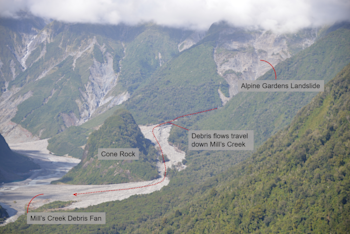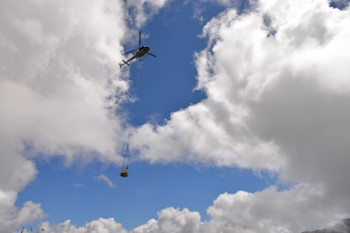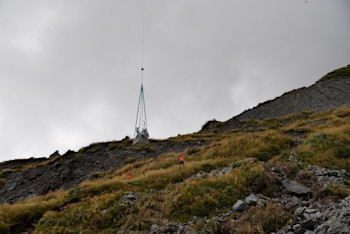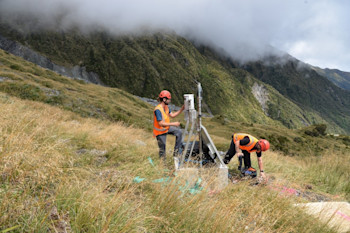National Advisory: Tsunami activity – expect strong and unusual currents and unpredictable surges at the shore following the M8.8 earthquake, Kamchatka Russia. For all information please visit NEMA (The National Emergency Management Agency) Only messages issued by NEMA represent the official warning status for New Zealand.

Alpine Gardens Landslide
The Alpine Gardens landslide in the Fox Glacier Valley is currently one of New Zealand’s largest actively moving landslides. The landslide is the source of debris flows that have been travelling down Mill’s Creek onto the Mill’s Creek debris fan.
These debris flows are very fast-moving surging flows of boulders and mud, which have caused damage to the Fox Glacier Valley accessway and necessitated a rerouting of the Fox Glacier viewpoint to the south side of the river.
We caught up with Engineering Geologist Saskia de Vilder to find out more about it.
How big is the landslide?
The Alpine Gardens landslide is approximately 50 million m³ in size. It’s a very dynamic and active landscape. Between June 2018 and June 2019, approximately 6 million m³ of material was eroded by debris flows from the landslide. Of this 6 million, 3 million m³ was deposited downstream on the Mill’s Creek debris fan, and 3 million m³ was washed away by the Fox River. To put this amount of erosion into context, that’s nearly 90,000 standard shipping containers.
How have we been monitoring the landslide?
The GNS Science landslide team went to the GeoNet technicians (Ashton McGill and Jackson Shanks) who came up with an innovative way to place monitoring equipment on the Alpine Gardens landslide. The technicians came up with a pre-fabricated, temporary monitoring station to reduce the amount of time exposed to the hazardous environment.
The large, unstable nature of the landslide, coupled with regular rockfalls, led the team to create a concrete and polystyrene base to fit within helicopter weight restrictions. On top of this base, the technicians mounted a case containing communication equipment, a solar power system, and the scientific equipment. The monitoring station was then lifted into place using a helicopter, and the technicians completed its assembly while on the landslide to reduce any impact from rockfalls, lightning strikes and Kea damage to the station.
The station will monitor the movement of the landslide over time, and how environmental conditions (such as rainfall, snowmelt etc) may affect this movement. This will allow us to understand the movement patterns and triggers of these types of landslides.
What have we learnt about the landslide?
The monitoring equipment was installed one year ago. Since then it has shown that the landslide has moved 50 m. The rate of movement of the Alpine Gardens landslide fluctuates in response to rainfall events, on average, it moves 115 mm/day but on some days, it moves a lot faster, and on other days it doesn’t move at all. After the storms in March 2019 and December 2019, the landslide moved at approximately 500 mm/day for several days before slowing down.
What next?
We do not know when this current period of heightened landslide activity will decrease, it could take several years. GNS Science is working with the Department of Conservation to monitor the landslide, as such events provide scientists with an important research opportunity to investigate why and how they move, and periodically “switch” on and off. This information will ultimately help the Department of Conservation plan their long-term response.
Given that these landslides are currently more active than they have been in the recent past, the hazard and risk they pose in the areas affected is currently elevated.
The National Emergency Management Agency (NEMA) have a great website with information on what to do before, during and after a landslide. And what supplies you need in an emergency.
The Earthquake Commission (EQC) have a helpful website with information on how to get your home, apartment, or rental prepared for a natural disaster such as a landslide.
Attributable to: Saskia de Vilder – GNS Science Engineering Geologist
Media contact: 021 574 541 or media@gns.cri.nz
All photos: Copyright GNS Science








